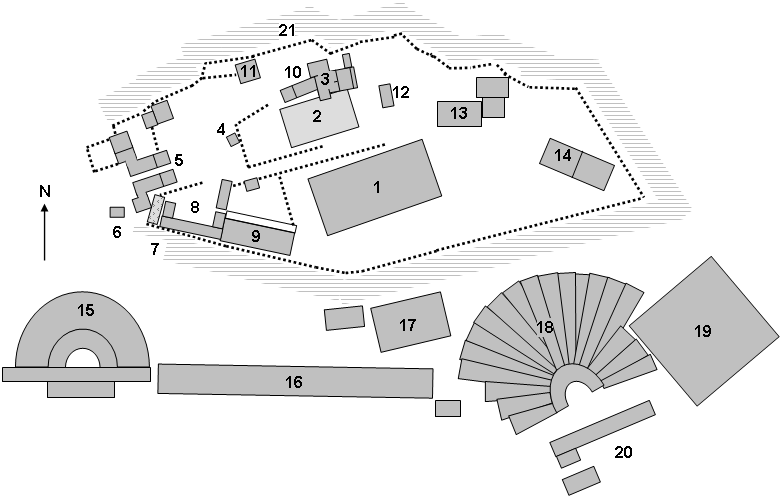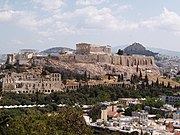
Ares is the Greek god of war. He is one of the Twelve Olympians, the son of Zeus and Hera. In Greek literature, he often represents the physical or violent and untamed aspect of war, in contrast to his sister, the armored Athena, whose functions as a goddess of intelligence include military strategy and generalship.

The Parthenon is a former temple on the Athenian Acropolis, Greece, dedicated to the goddess Athena, whom the people of Athens considered their patron. Construction began in 447 BC when the Athenian Empire was at the peak of its power. It was completed in 438 BC, although decoration of the building continued until 432 BC. It is the most important surviving building of Classical Greece, generally considered the zenith of the Doric order. Its decorative sculptures are considered some of the high points of Greek art. The Parthenon is regarded as an enduring symbol of Ancient Greece, Athenian democracy and Western civilization, and one of the world's greatest cultural monuments. To the Athenians who built it, the Parthenon and other Periclean monuments of the Acropolis were seen fundamentally as a celebration of Hellenic victory over the Persian invaders and as a thanksgiving to the gods for that victory.
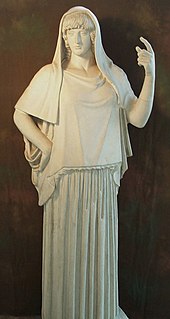
In Ancient Greek religion, Hestia is the virgin goddess of the hearth, the right ordering of domesticity, the family, the home, and the state. In Greek mythology, she is the daughter and firstborn child of Kronos and Rhea.
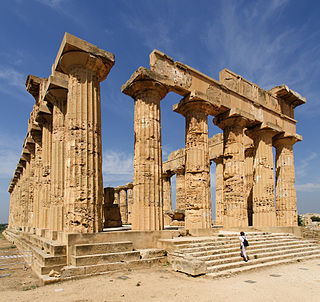
Selinunte was an ancient Greek city on the south-western coast of Sicily in Italy. It was situated between the valleys of the Cottone and Modione rivers. It now lies in the comune Castelvetrano, between the frazioni of Triscina di Selinunte in the west and Marinella di Selinunte in the east. The archaeological site contains five temples centered on an acropolis. Of the five temples, only the Temple of Hera, also known as "Temple E", has been re-erected. At its peak before 409 BC the city may have contained up to 30,000 people, excluding slaves.

The Areopagus is a prominent rock outcropping located northwest of the Acropolis in Athens, Greece. Its English name is the Late Latin composite form of the Greek name Areios Pagos, translated "Ares Rock". In classical times, it functioned as the court for trying deliberate homicide, wounding and religious matters, as well as cases involving arson or olive trees. Ares was supposed to have been tried here by the gods for the murder of Poseidon's son Halirrhothius.

Ancient Greek religion encompasses the collection of beliefs, rituals, and mythology originating in ancient Greece in the form of both popular public religion and cult practices. These groups varied enough for it to be possible to speak of Greek religions or "cults" in the plural, though most of them shared similarities.
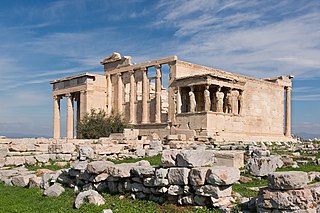
The Erechtheion or Erechtheum is an ancient Greek temple on the north side of the Acropolis of Athens in Greece which was dedicated to both Athena and Poseidon.

The Temple of Athena Nike is a temple on the Acropolis of Athens, dedicated to the goddess Athena Nike. Built around 420 BC, the temple is the earliest fully Ionic temple on the Acropolis. It has a prominent position on a steep bastion at the south west corner of the Acropolis to the right of the entrance, the Propylaea. In contrast to the Acropolis proper, a walled sanctuary entered through the Propylaea, the Victory Sanctuary was open, entered from the Propylaea's southwest wing and from a narrow stair on the north. The sheer walls of its bastion were protected on the north, west, and south by the Nike Parapet, named for its frieze of Nikai celebrating victory and sacrificing to their patroness, Athena Nike.

The Ancient Agora of Classical Athens is the best-known example of an ancient Greek agora, located to the northwest of the Acropolis and bounded on the south by the hill of the Areopagus and on the west by the hill known as the Agoraios Kolonos, also called Market Hill. The Agora's initial use was for a commercial, assembly, or residential gathering place.

In ancient Greek religion and mythology, the twelve Olympians are the major deities of the Greek pantheon, commonly considered to be Zeus, Hera, Poseidon, Demeter, Athena, Apollo, Artemis, Ares, Aphrodite, Hephaestus, Hermes, and either Hestia or Dionysus. They were called Olympians because, according to tradition, they resided on Mount Olympus.

Cape Sounion is the promontory at the southernmost tip of the Attic peninsula, 8 kilometres (5.0 mi) south of the town of Lavrio, and 70 kilometres (43 mi) southeast of Athens. It is part of Lavreotiki municipality, East Attica, Greece.

The Pergamon Altar is a monumental construction built during the reign of king Eumenes II in the first half of the 2nd century BC on one of the terraces of the acropolis of the ancient Greek city of Pergamon in Asia Minor.

The Pandroseion was a sanctuary dedicated to Pandrosus, one of the daughters of Cecrops I, the first king of Attica Greece, located on the Acropolis of Athens. It occupied the space adjacent to the Erechtheum and the old Temple of Athena Polias.
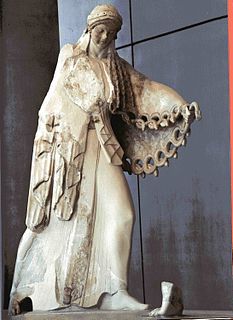
The Old Temple of Athena was an Archaic temple located on the Acropolis of Athens between the Older Parthenon and Erechtheion, built around 525-500 BC, and dedicated to Athena Polias, the patron deity of the city of Athens. It was destroyed by the Persians in 480 BC, during the Destruction of Athens. It was located at the center of the Acropolis plateau, probably on the remains of a Mycenaean palace. The complex is sometimes described by the name "Dörpfeld foundations", after the archaeologist who found the location of the temple. It was referred to as "Archaios Neos" by the Greeks.
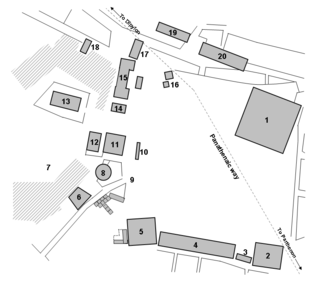
The Altar of the Twelve Gods, was an important altar and sanctuary at Athens, located in the northwest corner of the Classical Agora. The Altar was set up by Pisistratus the Younger, during his archonship, in 522/1 BC. It marked the central point from which distances from Athens were measured and was a place of supplication and refuge.

Temple of Agriculture or Altar of Agriculture is a historic site in Xuanwu District of Beijing, China, and located near the Temple of Heaven.
Ancient Greek temples were dedicated to a certain deity. A typical temple would have a statue inside. An altar would be placed outside, upon which offerings would be placed as sacrifices to the city's patron deity. The Parthenon is a famous example of an Ancient Greek temple.

The Temple of Athena is a hexastyle peripteral Doric temple built in Syracuse in the 5th century BC by the tyrant Gelo after his victory over the Carthaginians at the Battle of Himera. The temple was preceded by a cult site which dated back to the 8th century BC, with an altar discovered in excavation at the beginning of the twentieth century, and by an earlier temple from the middle of the sixth century BC.
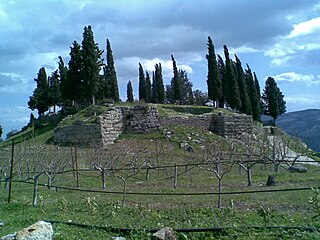
Titane or Titana (Τίτανα) was a town in the Sicyonia, upon the left bank of the Asopus, distant 60 stadia from Sicyon, and 40 from Phlius. It was situated upon the summit of a hill, where Titan, the brother of the Sun, is said to have dwelt, and to have given his name to the spot. It was celebrated for a temple of Asclepius, reported to have been built by Alexander, the son of Machaon, the son of Asclepius. This temple still existed in the time of Pausanias, in the middle of a grove of cypress trees, in which the servants of the god attended to the patients who came thither for the recovery of their health. Within the temple stood statues of Asclepius and Hygieia, and of the heroes Alexanor and Euamerion. There was also a temple of Athena at Titane, situated upon a hill, and containing an ancient wooden statue of the goddess. In descending from the hill there was an altar of the Winds.
